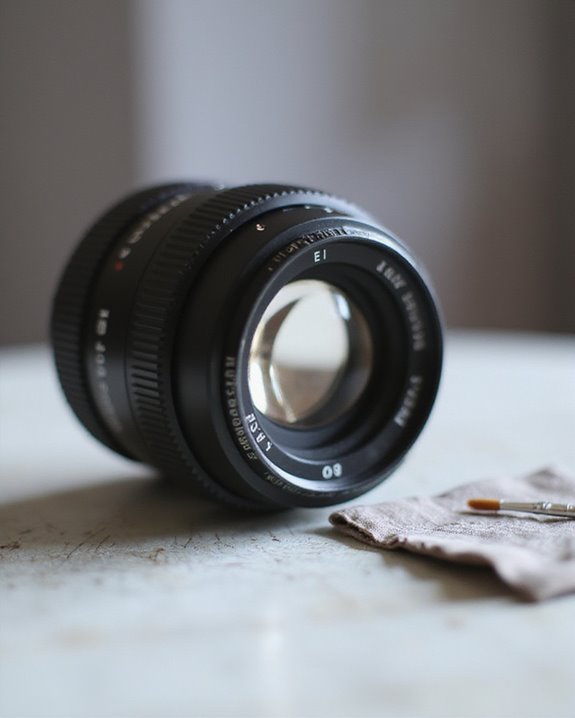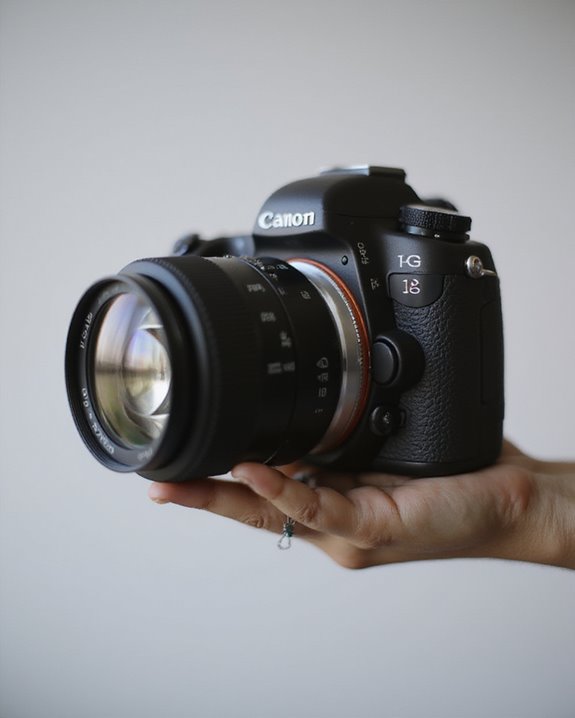Phone camera lenses require gentle cleaning for best photo quality. Start by powering down the device and using a blower to remove loose particles. Wipe the lens with a clean microfiber cloth using circular motions, applying minimal pressure. For stubborn smudges, slightly dampen the cloth with distilled water or lens solution, never applying liquid directly to the lens. Avoid paper towels or rough materials that can cause scratches. Proper maintenance techniques preserve lens coating integrity and extend camera performance.
Key Takeaways
- Use a blower or soft brush to remove loose dust particles before wiping the lens.
- Clean with gentle circular motions using a microfiber cloth for light smudges and fingerprints.
- For stubborn marks, slightly dampen a microfiber cloth with distilled water or lens cleaning solution.
- Never apply cleaning liquids directly to the lens as this can damage internal components.
- Regularly inspect and clean your phone’s camera lens to maintain optimal photo quality.
Phone Camera Lens Cleaning Preparation Steps
Five essential preparation steps guarantee best results when cleaning a phone camera lens. Initial power shutdown prevents accidental button presses during the cleaning process, while disconnecting chargers and cables guarantees complete device safety. Users should thoroughly inspect the lens for visible debris that may require special attention, then remove any protective case to gain unrestricted access to the camera components. Using a professional-grade lens cleaner can help ensure safe and effective cleaning without damaging coatings. Environment setup plays a vital role in effective lens maintenance, requiring a stable, flat surface away from direct sunlight to prevent glare and potential damage. Choosing a relatively dust-free area minimizes the risk of re-contamination during cleaning. Placing the device on a soft surface protects against scratches, while making sure hands are clean and dry prevents transferring oils or dirt to the sensitive lens surface.
Essential Tools for Proper Lens Maintenance
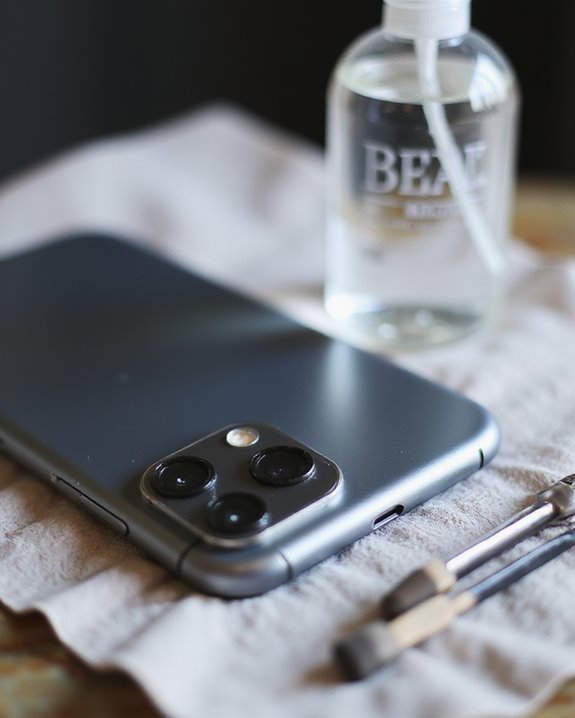
The right collection of cleaning implements forms the foundation of effective phone camera lens maintenance, ensuring ideal image quality and preventing potential damage. Microfiber cloths remain the primary tool, providing gentle dust removal without scratching delicate lens coatings, while specialized lens pens offer precision for stubborn smudges. Additionally, using non-abrasive cleaning solutions like ZEISS wipes or diluted isopropyl alcohol helps maintain the lens coating integrity during cleaning. Tool innovations have introduced compact portable kits with retractable brushes and magnetic caps, perfectly sized for on-the-go smartphone users. Material comparisons reveal significant differences in effectiveness, with lint-free options like Kimwipes proving superior to standard tissues that leave residue. A quality blower bulb removes loose particles before wiping, while ZEISS optical cleaning fluid or diluted isopropyl alcohol solutions provide safe cleaning without harming anti-reflective coatings. For protection between cleanings, lens caps and protective filters serve as preventative accessories against environmental contaminants.
Step-by-Step Lens Cleaning Techniques
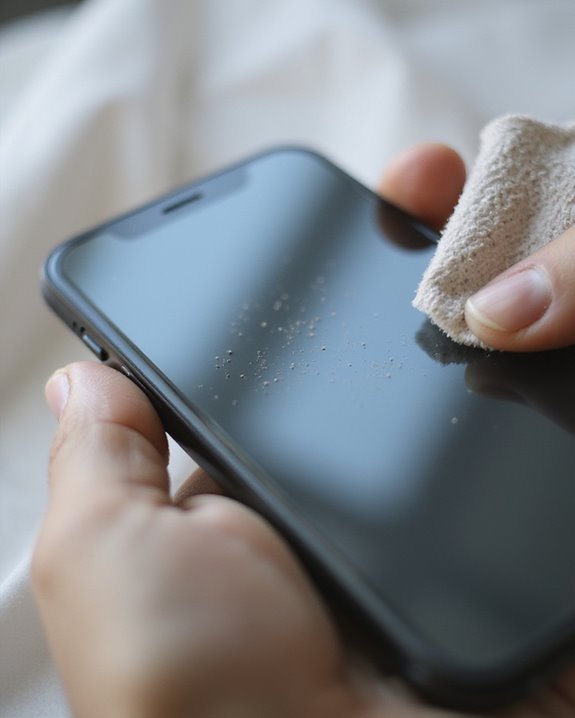
Mastering proper lens cleaning techniques guarantees best phone camera performance and prevents potential damage from improper handling. Following sequential steps guarantees thorough cleaning without risking lens integrity. Begin by visually inspecting the lens to identify contaminants, determining whether loose debris or stubborn smudges require attention. For dust particles, use a gentle air blower or soft-bristle brush, angling the airstream to avoid pushing particles into crevices. Next, application methods vary based on dirt type—use a dry microfiber cloth with circular motions for light smudges, applying minimal pressure. For persistent marks, slightly dampen the cloth with distilled water or lens cleaning solution, followed by thorough drying. Complete the process with a final polish using a clean section of microfiber cloth, inspecting under good light to confirm all streaks are removed. To ensure effective cleaning, consider using a specialized camera lens cleaning kit that includes tools like microfiber cloths, cleaning solutions, and air blowers for optimal results.
Advanced Methods for Stubborn Smudges and Dirt
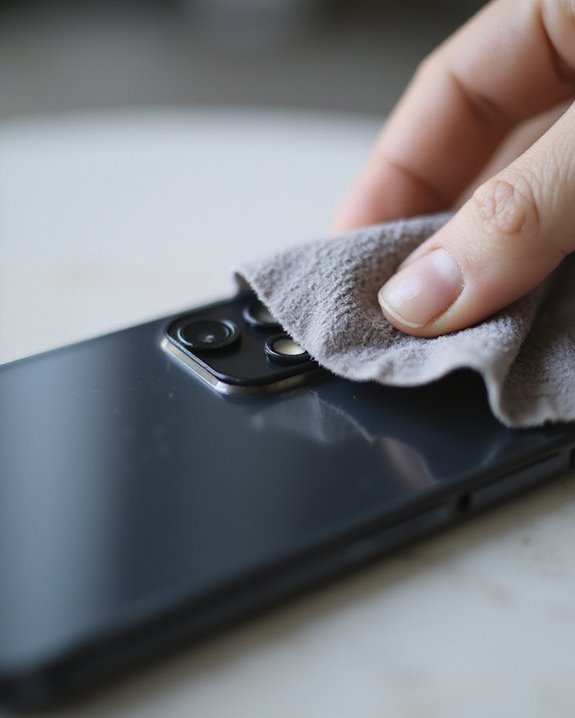
While standard cleaning methods effectively address everyday lens smudges, persistent dirt and oily residue sometimes require more advanced approaches to restore optical clarity. Ultrasonic Innovations offer professional-grade cleaning capabilities, using specialized machines that penetrate deeply into crevices where regular cloths cannot reach, making them ideal for heavily soiled lenses.
For stubborn spots, Homemade Formulas provide an effective alternative to commercial products. A solution of 50% isopropyl alcohol (70% concentration) and 50% distilled water, applied to a microfiber cloth, can tackle oily fingerprints without leaving streaks. When applying this mixture, users should avoid direct contact with electrical components and never spray directly onto the lens. For precise cleaning of hard-to-reach areas, specialized tools like lens cleaning pens and soft-bristled brushes can safely dislodge debris from around lens edges and filter threads.
Common Mistakes to Avoid When Cleaning Camera Lenses
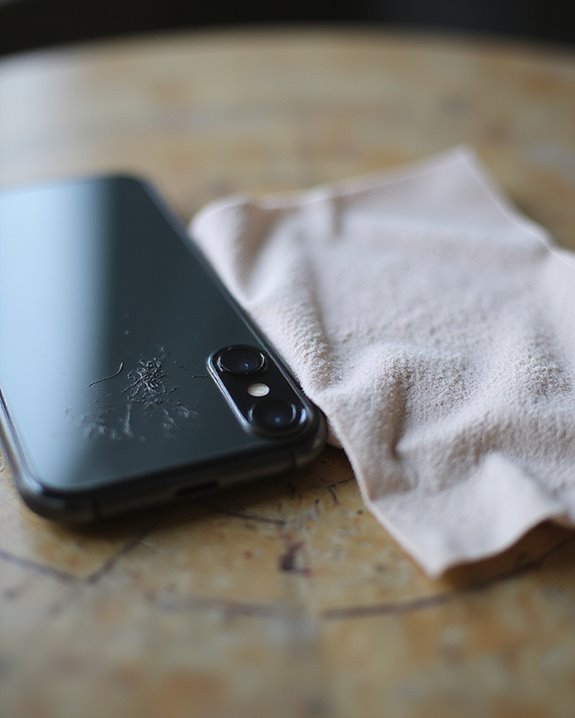
Cleaning a smartphone camera lens incorrectly can lead to permanent damage, greatly decreased image quality, or even complete malfunction of the camera system. The most common Error Causes include applying cleaning liquids directly to the lens, using rough materials like paper towels, and exerting excessive pressure during cleaning. For effective Smudge Prevention, users should avoid circular motions that create streaks and always power off devices before cleaning.
Many individuals mistakenly use household glass cleaners containing harsh chemicals that strip protective lens coatings, or fail to remove loose debris before wiping. Proper technique requires gentle handling with microfiber cloths, never touching lenses directly with fingers, and ensuring complete drying after cleaning. Regular maintenance with appropriate materials prevents permanent damage, while storing phones in protective cases minimizes dust accumulation and scratches.
Long-Term Protection Strategies for Phone Camera Lenses
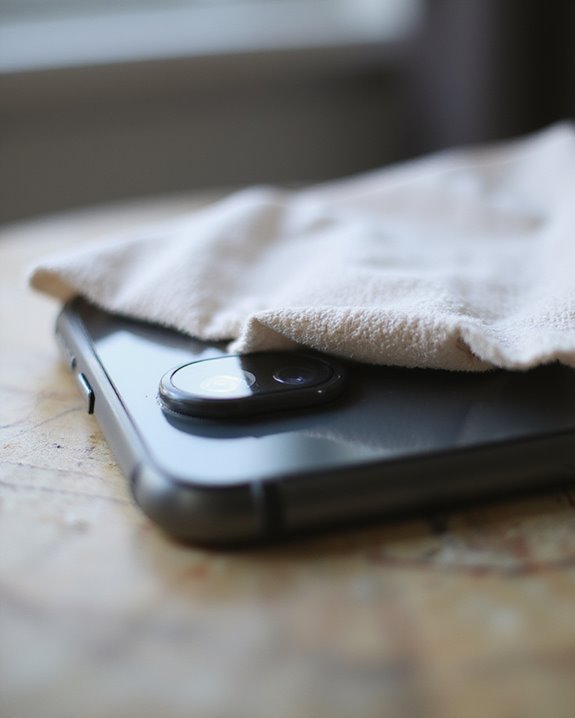
The long-term protection of smartphone camera lenses requires a thorough approach that extends beyond routine cleaning. Implementing Durability Enhancements, such as protective cases with raised bezels and dedicated lens protectors made of tempered glass, greatly reduces the risk of scratches and impact damage. TPU covers effectively distribute shocks, preserving lens integrity during accidental drops.
Environmental Safeguards play an equally vital role in lens preservation, requiring users to shield devices from extreme temperatures, humidity, and direct sunlight. When not in use, lens covers prevent dust accumulation and potential scratches. Regular inspection for damage, coupled with professional repair when necessary, maintains ideal functionality. Storing phones in clean environments and using purpose-designed cleaning tools further extends lens lifespan, ensuring continued high-quality image capture without degradation over time.
Frequently Asked Questions
Can I Use Alcohol Wipes to Clean My Phone Camera Lens?
Alcohol wipes pose risks to lens coatings and may damage specialized finishes. Users should consider gentler wipe alternatives like microfiber cloths with lens-specific solutions, following manufacturer guidelines to maintain optical integrity and performance.
How Often Should I Clean My Phone’s Camera Lens?
A suitable cleaning schedule for phone camera lenses is typically weekly, though usage impact matters. Heavy users in dusty environments should clean more frequently, while light users in clean areas may need less maintenance.
Will Cleaning Affect My Lens’s Anti-Reflective Coating Over Time?
Phone photographers obsess over coating longevity while scrubbing away. Effects analysis reveals that improper cleaning techniques can indeed degrade anti-reflective coatings over time. Gentle methods with appropriate materials will preserve these delicate optical enhancements.
Can Scratched Phone Camera Lenses Be Repaired?
Minor scratches on phone camera lenses can be addressed with DIY solutions like toothpaste or specialized polishers. Deeper damage requires professional repair options, including lens polishing services or complete replacement when necessary.
Is Compressed Air Safe for Cleaning Phone Camera Lenses?
Compressed air poses risks to phone camera lenses due to potential air contaminants and moisture risk from propellants. Camera lens blowers offer a safer alternative that avoids potential damage to sensitive internal components.


